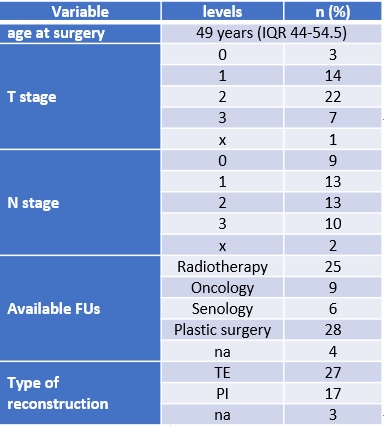Halfmoon radiotherapy: a real-world experience in a single institution
PO-1278
Abstract
Halfmoon radiotherapy: a real-world experience in a single institution
Authors: Maria Alessia Zerella1, Samantha Dicuonzo1, Mattia Zaffaroni1, Marianna Alessandra Gerardi1, Damaris Patricia Rojas1, Anna Morra1, Denis Nicolò2, Raffaella Cambria3, Rosa Luraschi3, Federica Cattani3, Roberto Orecchia4, Maria Cristina Leonardi1, Barbara Alicja Jereczek-Fossa1
1Istituto Europeo di Oncologia, Radiotherapy, Milan, Italy; 2Università degli Studi di Milano, Oncoematology, Milan, Italy; 3Istituto Europeo di Oncologia, Medical Physics, Milan, Italy; 4Istituto Europeo di Oncologia, Scientific Direction, Milan, Italy
Show Affiliations
Hide Affiliations
Purpose or Objective
The increasing use of immediate breast reconstruction (IBR) after mastectomy and its interaction with post-mastectomy radiotherapy (PMRT) has become a subject of great interest. In fact, besides the potential impact of RT on the cosmetic results, the reconstructed breast may affect the ideal target coverage and the optimal OARs sparing. Preliminary experience with implant-sparing RT using the HALFMOON (Helical ALtered Fractionation for iMplant partial OmissiON) technique and target contouring according to ESTRO-ACROP recommendation has been reported
Material and Methods
Breast cancer patients treated with mastectomy, either total or nipple sparing, and immediately reconstructed with implants (either tissue expander -TE or permanent implant-PI) and receiving Halfmoon RT by using TomoTherapy® Hi-Art System (Tomotherapy Inc., Madison, WI) in helical modality (TomoHelical) at the IEO between February 2020 and January 2021 were considered for the analysis. All the implants were placed beneath the pectoral muscle. As for our clinical practice, TE was fully inflated before RT.
Contouring was based on ESTRO/ACROP guidelines for PMRT after implant-based IBR. The chest wall CTV is composed of ventral part (between the skin and the implant); in case of adverse tumor factors, the partial dorsal part (between the implant and the rib wall) is added to ventral CTV.
Data about capsular contracture of the breast implant were collected according to the Baker classification
Results
A total of 47 patients were analysed and their baseline characteristics are reported in Table 1. For patients reconstructed with TE, median time to TE substitution was 17.75 months. Considering patients with an IBR with PI only 1 patient out of 17 required implant substitution after 20 months. Toxicity assessment of capsular contracture, in a radiotherapy and/or plastic surgeon FU, was available for 34 out of 47 patients (72.3%) with a median follow-up (FU) of 1.2 years (IQR 1.0-1.7), Data about capsular contracture were available for 32/34 patients, with 28 of them reporting Baker grade ≥ 2, data were missing for 2 patients.

Conclusion
From the reported experience implant sparing RT using Halfmoon technique is technically feasible and preliminary data demonstrate an acceptable rate of capsular contracture. Data concerning additional toxicities and oncological outcomes are being retrieved.